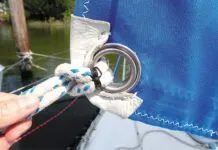AFTERMARKET EXHAUST
I have really appreciated the refit series from John Stone you’ve published (see “Rebuilding a Cape Dory 36,” PS November 2022). As someone beginning to plan our own extensive refit, this has been tremendously helpful, especially his notes about what we would have changed a few years out from the original project.
On a related note, I wanted to praise HDI Marine (www.hdimarine.net), which makes aftermarket stainless steel exhaust components. When the mixing elbow on our Yanmar 3GM30F cracked, I originally planned to order a new OEM component, as we normally do. However, a little research showed that HDI made a high-quality stainless-steel elbow, which was also cheaper than the OEM cast iron version. True to their claim, all of the components fit exactly. Even further, their responsiveness and customer service is absolutely top notch.
Mike Cilenti
Bristol Channel Cutter
Alexandria, VA
WINDOW REPLACEMENT TIPS
Regarding your recent report on window replacement, (see “F-24 Portlight Replacement,” PS October 2023), having replaced all of the acrylic windows on our Macintosh 47, I have a few tips.
If you are replacing the windows, use the old ones as a template, cut them out slightly oversized, then use a router/table with a trimmer bit. It will duplicate your piece exactly. Then use a trimmer bit with a 45-degree angle to put a bit of bevel on your new window. Work slowly, so you won’t heat up the work.
When using Dow 795, pay attention to the expiration date. Do not use previously opened tubes (unless just a few days have passed), or tubes nearing or past their expiration date. It’s critical. While removing old sealant is tedious (I used a Dremel with wire brushes), getting the windows out is the hard part.
If you are putting new acrylic in, get a piece of ⅝- to ¾-inch line, drill an appropriately sized hole near the end of the old, still installed window, put the line through the hole, tie a figure 8 on the inside. Have a helper pull on the line while you use razor blades, putty knives, etc. on the inside. This will make the work go way faster.
If your windows have a bend in them, this is what we did: They should match, port and starboard. Make a template for each window, so that you can bend them to the new shape. Ours were bent along a horizontal line, making it pretty easy; we could get by with just one template.
You can use Hydrocal—a strong casting plaster—to make a mold from the old windows. Take one of them and flatten it with a heat gun. This gives you a template to make new windows from. Make two templates. Use a heat gun (or two) to slowly heat up the new acrylic. Practice a lot on scrap pieces first. It’s really easy to burn the plastic, or get bubbles in it. Use your mold to make the new ports.
For a great discussion on acrylic versus polycarbonate, check out Tony’s blog at www.hatchmasters.com.
Bill and Jan Streep
Macintosh 47
Bocas del Toro, Panama
STOPPING EPOXY BLURP
First, thank you so much for the consistently useful and well-written articles. Second, I thought your readers would want to know that there is a way to mix very small batches of epoxy, using a method and DIY system that my husband devised.

Philip spent his life designing and making things. Mostly out of wood, always made to look graceful, and often including epoxy as glue or coating. I’ve attached a photo of a lightweight plywood tender (below left) that he designed and built with a movable stern seat to accommodate one or two passengers. Being frustrated with the “blurp” factor as air leaves the pump when mixing small batches of epoxy, he created simple shop balance, photographed it, and wrote the instructions. We posted photos and detailed instructions for making the balance on www.hammerandthumb.com. Philip is in heaven now, hopefully with many elves and a shop filled with useful tools.
Kristin Zhivago
Herreshoff Stuart Knockabout
Jamestown, RI




































